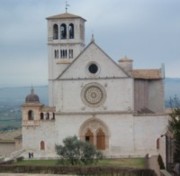Hotels, Travel and Tourist Guide
Assisi is one of Italy’s prime tourist attractions; a simple and peaceful town with a rich religious heritage. It rejoices in many good, small hotels, excellent restaurants and a friendly, welcoming atmosphere. The town is situated in green Umbria, on the slopes of Monte Subasio.
> Assisi hotels, B&Bs, villas and apartments
Assisi Travel Information
Get to Assisi
Assisi is around two hours by train from Rome – there are a few direct trains, otherwise you change at Foligno. Perugia is a short direct journey away, by bus or train. The nearest airport (with Ryanair flights from London Stansted) is Perugia Airport, just a few miles away. At the time of writing there’s no direct bus connection between the airport and Assisi – you would have to take the airport bus into Perugia and change. A taxi is a more convenient option for reaching the town.
Get around
The train station for Assisi is located on the plain, around three miles from the town, at Santa Maria degli Angeli. A speedy bus service (line C) runs from outside the station up into the historical heart of Assisi) – buy bus tickets from the little newsagent inside the station. Two further bus routes make circuits of Assisi, in case you get tired of walking up and down the sloping streets.
Assisi Tourist Information Office is located in Piazza del Comune (closed lunchtimes, as are most of the town’s attractions).
Assisi Tourist Information
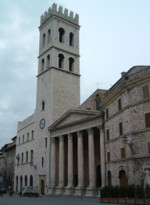
Assisi is a good town for wandering and exploring. Its narrow and steep lanes are picturesque and conceal plenty of surprises: a hidden restaurant, a faded fresco, a stunning view. Occasional olive groves are dotted among the stairways and rooftops, where shy cats creep out of sight of passers-by. After the earthquake it suffered in 1997, Assisi has been carefully rebuilt and restored; the town has a well-kept and well-off feel to it. There are still repairs being carried out, and work on some of Assisi’s frescoes will go on for years, but most of the buildings, streets and monuments are restored and open for business.
You don’t have to be a pilgrim to appreciate Assisi, but it helps if you have some interest in churches. For hundreds of years Assisi has been dominated by the unpretentious figure of St. Francis, whose followers filled the little town with churches, monasteries and shrines. Everywhere you look in Assisi, you’ll find another fine church, mostly built in the pretty pink stone which defines the town’s appearance, and mostly containing fine artworks and a few Franciscan relics. The grandest of these, of course, is the Basilica di San Francesco, the important double-decker church built to honour the humble saint, who lies in the crypt. The lower level is the older, and the more atmospheric, with stained glass windows, and frescoes attributed to Giotto, Cimabue and Simone Martini. The upper church was damaged more severely by the earthquake, but it is bright and airy and its colourful frescoes by Giotto, Cimabue and others can still be admired.
Assisi’s other attractive churches are numerous; among the finest are the Basilica di Santa Chiara (St. Clare’s); the seventeenth-century Chiesa Nuova, a small church built over St. Francis’s presumed birthplace; and San Pietro, which has an interesting underground museum with varied exhibits and some Roman remains. The ruins of another Roman house can be seen in the crypt of Santa Maria Maggiore. Wallpaintings from these excavations can be seen in the town’s little museum, just off Piazza del Comune, which is well worth a visit. As well as archeological finds from the area, the museum gives access to a long tunnel running right under the modern piazza. Here you can walk on the original surface of the town’s Roman Forum, and see the base of the Temple of Minerva which still dominates the heart of the town (its columns are now the facade of Santa Maria sopra Minerva church, which has a pretty blue-and-gold gallery).
The town’s attractive main street is the Via San Francesco, which runs from the Basilica up to Piazza del Comune. There are many interesting buildings along the way, including the frescoed Oratorio dei Pellegrini (Pilgrims’ Oratory), and the town’s art gallery, the Pinacoteca Comunale. The latter contains a number of interesting paintings and frescoes, many of which decorated the walls and gateways of the town.
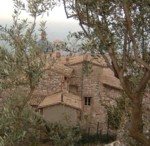
For the best view over the town, follow signs to the Rocca Maggiore, the large fortress towering above Assisi. As well as the town itself, there are spectacular views over the surrounding plains, hills and valleys. If you fancy a more strenuous walk, you could head up the wooded slopes of Monte Subasio. From Piazza Matteotti, at the top of the town, walk uphill to the Porta Cappuccini gateway in the town wall – you’ll see a map of the Monte Subasio park and the dirt path and road leading to Eremo delle Carceri, the hermitage in the woods to which St. Francis retreated for prayer. Close to the Piazza Matteotti you can also visit the little curved street which traces out the form of Assisi’s old Roman Ampitheatre.
Santa Maria degli Angeli, by the railway station, is described as a suburb of Assisi, but it’s really a distinct settlement. Pleasant, but without the charm of historical Assisi, the town has a couple of sights of interest. The Basilica di Santa Maria degli Angeli is an important stop on the St. Francis trail. Enclosed within the huge church is a tiny chapel, the Porziuncola, an ancient Benedictine place of worship that St. Francis took over, and the Capello del Transito, marking the spot where the saint died. Following the signs to St. Francis’s rose garden (roseto), you pass the surprising and sweet sight of doves nesting on a statue of St. Francis. To get there from the station, turn left and walk until you reach a level crossing over the railway tracks. Cross over and continue straight on until you reach the Basilica on your left. The bus for Assisi (line C, see below) stops outside. A more modern attraction is the Lyrick Theatre, which puts on touring musicals and concerts (look out for posters around town, or ask in the Tourist Information Office.)
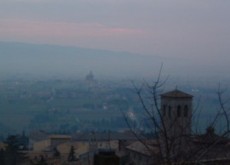
There are plenty of places to eat and drink in Assisi. If you don’t fancy the most obvious (and expensive) tourist options, walk further from the Basilica di San Francesco. Signs pointing down narrow lanes will direct you to Assisi’s many small restaurants and pizzerie. In the central part of town, I Monaci (Piazzetta Verdi – 10, Via Scalete) offers good pasta dishes and pizzas. Just above Piazza del Comune, the Osteria Pozzo della Mensa is an excellent restaurant offering local specialities – see below for our review.
Assisi Restaurant Experience – We enjoyed an excellent long lunch at the Osteria Pozzo della Mensa (11b, Via Pozzo della Mensa). A treat for gourmands, the restaurant specialises in carefully-selected local products. Between us we enjoyed cheese with organic honey, ricotta and lemon pasta, pheasant and umbrichelli pasta with Umbrian sausage and mushrooms. For dessert the choice included a delicious chocolate and pear cake.
> Assisi hotels, B&Bs, villas and apartments
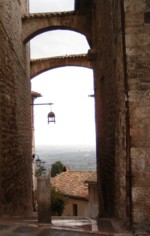
On this site
Useful links
